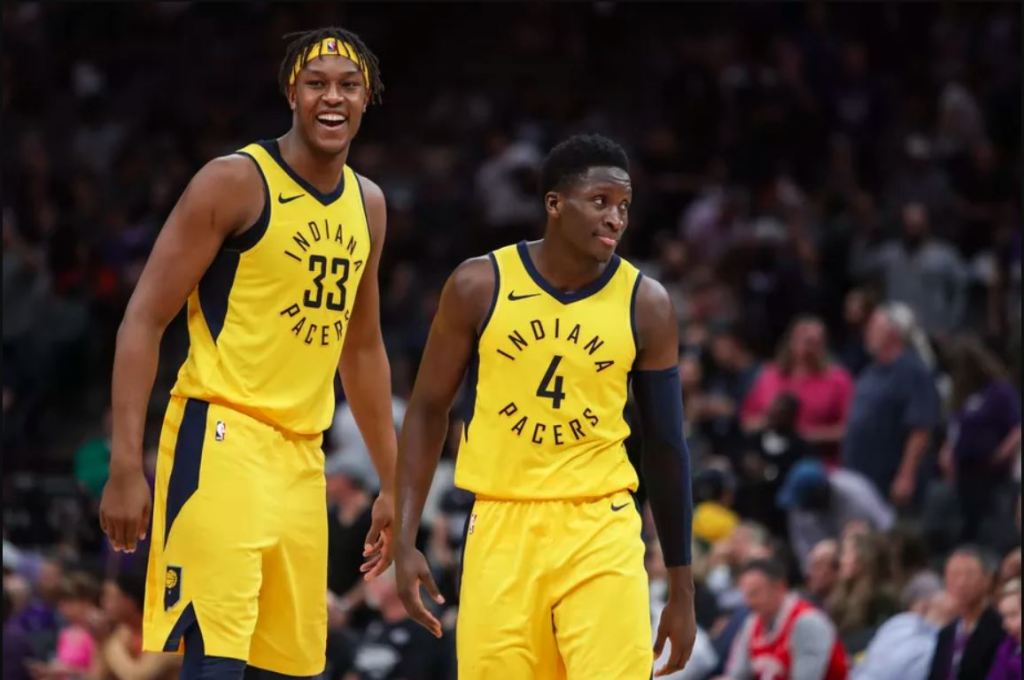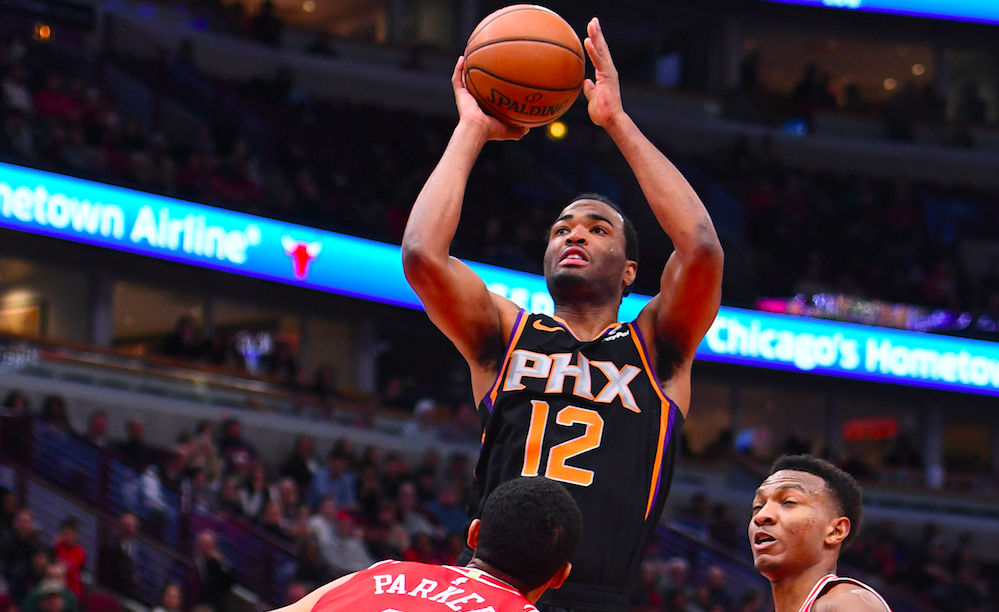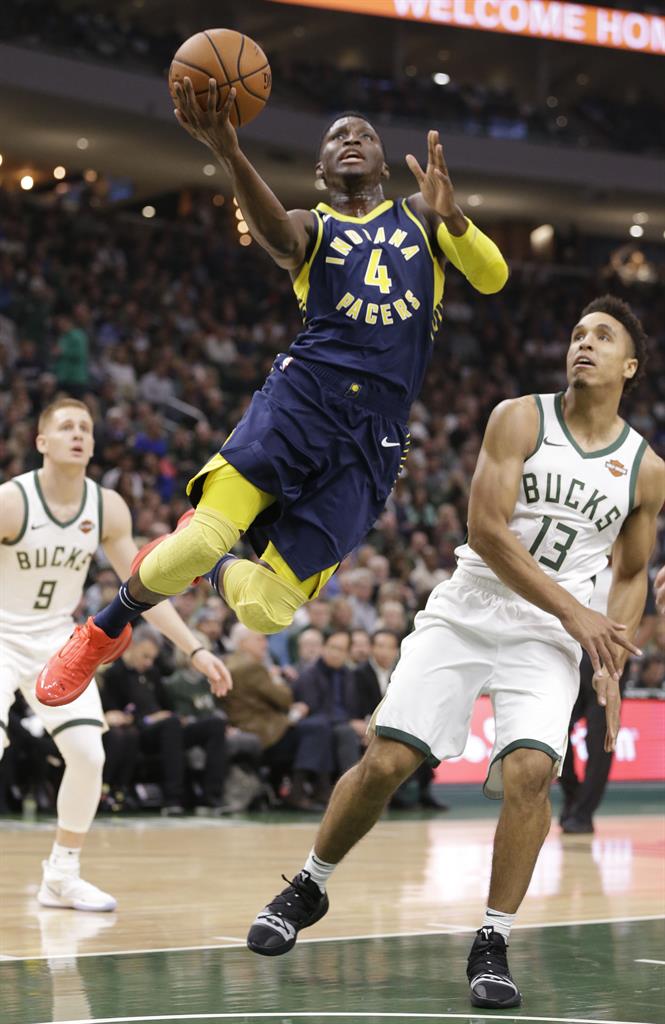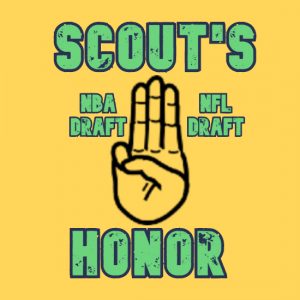Defining question of the year: What happens with Victor Oladipo’s recovery?
On January 23rd of this year, Indiana Pacers star guard Victor Oladipo went down. The silence draped over the stadium was deafening. Right away the severity of the situation was evident, as the trainers rushed to his side and draped a towel over his leg, and players on both sides huddled around in stoic silence.
That night, Oladipo ruptured the quad tendon in his right knee, a devastating injury for any NBA player, but especially for a stud athlete of Oladipo’s caliber. The biggest concern is the physical recovery; no leg injury is ever offers a simple road to recovery, but the quad tendon is a particularly tricky one, and one the NBA world has little experience with. In basic terms, the quad tendon is what allows you to bend your knees. For a normal person, losing this ability is incredibly frustrating. In a complete tear, it isn’t even possible to walk without surgery. For a professional athlete, losing the ability to bend your knees is catastrophic. ACL tears are often thought of as the ultimate season-ending injury, and this is probably fair; it seems no season-ending injury occurs nearly as much as the ACL tear. But an ACL tear affects your lateral movement – cutting in space, defending on the perimeter, shuffling sideways – all become virtually impossible without a functional ACL. But with a torn quad tendon? You can’t use your legs. With an ACL injury, you can stay in shape as an athlete – squats, running, anything that doesn’t require side-to-side movement. With a quad tear? No squats. No running. No movement. Your leg is virtually unusable until after surgery, and at that point it requires months of rehab to regain basic use of the leg, which means even more months of trying to restrengthen the atrophied muscles. This final phase of recovery has got to be the most difficult for athletes like Oladipo, the phase where you have regained basic functionality of the torn ligament but cannot contribute anything at the astronomically high level the NBA requires. The agony of watching your team play without you, knowing full well that you could run up and down the court if you wanted to, but understanding deep down that your place for now is on the sideline. It would be like a renowned writer recovering from a head injury, with all the thoughts, ideas, phrases and quips floating around in his or her head, simply unable to translate the brilliance in one’s mind to the world around them. That has to be incredibly frustrating, and it comes as no surprise it has been reported that Oladipo was absolutely miserable last season sitting out some of the later games when he had lingering leg injuries prior to the quad tendon tear.

To be quite frank, that’s what really scares me. Victor Oladipo is a guy who has flown under the radar his entire life; even as the #2 overall pick in the 2013 draft, he was quickly forgotten about in the general consciousness of the NBA world. To say he plays with a chip on his shoulder is an understatement. So of course Oladipo wants to do everything in his power to “prove the doubters wrong,” and unfortunately that means trying to come back from injury as quickly as possible. When I first started writing this section, I intended to fall back on a much easier explanation of how the mentality of Oladipo could be his downfall. I was going to reference the Gordon Hayward injury, and how he simply hasn’t been nearly as aggressive and confident in his movements, how he has lost much of the edge he used to play with. But the more I think about it, the less that concerns me. Yes, it happens, but there are plenty of cases of players coming back from catastrophic injuries to play at the same or even greater levels of intensity than before. For me, the concern is that Oladipo is too fiery, too confident. My worry is that Victor understands his career and his legacy in no uncertain terms, and understands that this year and the couple that follow could really cement him as not just a great player of his era – Victor Oladipo absolutely has the talent to be a historically great player, especially if he was to remain in Indiana for the next few seasons and become a true icon there. He also understands that while the $80 million contract he is on right now is generational wealth, there will be one more opportunity to land a massive contract; when his deal is up in two seasons, it is quite possible Oladipo could ink a deal worth over $200 million in its entirety.

Victor Oladipo has a hell of a lot to play for next season, both on a personal level, and as the leader of this competitive Indiana Pacers squad. I tend to be a bit of an optimist, so I have a hard time forecasting anything less than a return to stardom next season, but the historical precedence for this type of injury to this caliber of athlete is pretty much nonexistent. Reporting from the Pacers suggests a return sometime in December of this year, but those familiar with the team and with Victor have suggested he could push to return earlier, given his tremendous work ethic. When he returns is certainly going to affect the Pacers, but even bigger is the question of how long it takes for the team to mesh around him. This is a team that really shuffled the deck chairs this offseason, so growing pains are already expected. Will the return of Oladipo galvanize the team and rapidly push them up the East standings? Or will it further confuse the Pacers, who must now adapt to a new offensive centerpiece? These questions and more will define this season for Indiana.
Biggest Wild Card: T.J. Warren

Any team that loses a free agent of the caliber of Bojan Bogdanovic is going to have trouble completely replacing that production. This is even more stark given that Bojan was a small forward, the most shallow position in the league, and one with high level offensive creation ability – a rare skill among forwards. The Pacers do have Doug McDermott at the 3, and I’m sure we will see minutes where Jeremy Lamb acts as the small forward, but it seems clear to me that the bulk of the minutes are to be redirected to the newly acquired T.J. Warren. T.J. played the past five seasons in Phoenix, the past three of which he has been a starter for the Suns. In his first four seasons, Warren was primarily a SF, playing fewer than 30% of his minutes at PF each year. However, due to the acquisition of former Wizard Kelly Oubre and Villanova rookie Mikal Bridges, Warren played 99% of his minutes at PF. On paper, this doesn’t sound like that much of a shift; after all, he was playing significant minutes at PF the past few years, and hey, he’s still a forward, how much different can it be? But there is a massive difference in lining up against a SF every night versus a PF; even if the line dividing the two is more blurred than ever, there is still a clear distinction when we talk about playing an entire season at the position. On average, your opponent at the 4 is stronger, taller, and more of an interior presence than your average 3. But your opponent at the 4 is also slower, generally less explosive, usually less of an offensive threat, at least as an on-ball threat. Playing the 3 means guarding the LeBrons of the world, the Kawhis of the world. The SF position is certainly the most shallow in terms of starter talent, but across the NBA, many of the biggest, most productive stars play that exact position.

So, where exactly am I going with all of this?
The point I am trying to make is that it is incredibly difficult to replace a high level small forward over the course of a single offseason, and it is virtually impossible to do so during the season. T.J. Warren is a great gamble for the Pacers – not only did they not have to give up assets, they actually received the #32 overall pick in the ‘19 draft from the Suns to take him on – but he is a gamble nonetheless. Here are his games played totals from the past few years:
Per https://www.basketball-reference.com/
| Season | Age | G | GS | MP |
| 2014-15 | 21 | 40 | 1 | 15.4 |
| 2015-16 | 22 | 47 | 4 | 22.8 |
| 2016-17 | 23 | 66 | 59 | 31.0 |
| 2017-18 | 24 | 65 | 65 | 33.0 |
| 2018-19 | 25 | 43 | 36 | 31.6 |
| Career | 261 | 165 | 27.7 |
Warren has dealt with several injuries during his career, and it is naive to imagine this will finally be the year he starts 82 games. What happens to the Pacers if Warren misses 20 games, not to mention the 39 he missed last season? The Pacers have very little room for error on the SF line, and it is always misguided to assume the best.
This isn’t even to mention the shooting situation with Warren.
Per https://www.basketball-reference.com/
| Season | Age | 3P | 3PA | 3P% | 2P | 2PA | 2P% | eFG% | FT | FTA | FT% |
| 2014-15 | 21 | 0.1 | 0.5 | .238 | 2.7 | 4.8 | .560 | .540 | 0.4 | 0.5 | .737 |
| 2015-16 | 22 | 0.6 | 1.5 | .400 | 4.1 | 7.9 | .520 | .533 | 1.0 | 1.4 | .703 |
| 2016-17 | 23 | 0.4 | 1.5 | .265 | 5.7 | 10.8 | .527 | .511 | 1.8 | 2.3 | .773 |
| 2017-18 | 24 | 0.3 | 1.4 | .222 | 7.8 | 15.0 | .523 | .507 | 3.0 | 3.9 | .757 |
| 2018-19 | 25 | 1.8 | 4.2 | .428 | 5.1 | 10.0 | .510 | .549 | 2.3 | 2.9 | .815 |
| Career | 0.6 | 1.8 | .340 | 5.4 | 10.3 | .524 | .522 | 1.8 | 2.4 | .766 |
How in the hell do we even begin to try to predict how Warren shoots next year? This is a guy that has consistently show well from the free throw line, consistently finished well in the lane, has always shown off a pretty tremendous level of touch. Was last year an example of Malcolm Gladwell’s theoretical “tipping point?” Or was he simply on a hot streak, fresh off of a summer shooting nothing but threes? I tend to lean more towards the former, that something has clicked with Warren’s game, and that he has refined his mechanics to the point that he can be a moderately efficient 3pt shooter on a moderate volume – say, 37% on 4.5 attempts per game.
But what happens if he shoots like he did in ‘16-’17 or ‘17-’18? The Pacers reportedly moved on from Thaddeus Young this offseason because they were concerned he was having too negative an impact on their offense due to his reluctance to shoot from deep. Well, Young was a yearly All-Defensive candidate that allowed Myles Turner and Victor Oladipo to turn into the defensive hawks they have become. What happens if T.J. Warren ends up filling into the role of Thad Young, a PF without the threat of shooting from 3? What if the Pacers gave up on one of the best defensive forwards in the game today to bring on a guy just as offensively limited yet with below average defensive play? If you told me T.J. ends up shooting 40% on 7 3’s a game and fills in 95% of the production Bogdanovic gave them last year, I wouldn’t be shocked. Yet if you told me T.J. ends up struggling offensively, and is relegated to a role primarily consisting of bench PF minutes, I again would not be shocked. While there are certainly other players with greater upsides, and plenty of other players with greater downsides, few have the expansive range of outcomes T.J. Warren presents.
/cdn.vox-cdn.com/uploads/chorus_image/image/64083943/usa_today_12331645.0.jpg)
I personally expect Warren to have his best season of his career to this point. This will be his first season in an organization with any semblance of stability and structure, and he will have the best offensive (and defensive) talent surrounding him to this point in his career. However, the risk here is monumental, and it would be negligent not to take note of it. If Warren isn’t able to sustain at least some of his superb shooting from the previous season, or if he struggles with injuries and rehab throughout the season, then the Pacers are in huge trouble, as they have virtually nothing left in reserve if Warren doesn’t work out. No other core piece has as much uncertainty as Warren, and yet he has to be considered a core piece, as the Pacers truly have no way to replace him outside of a trade. Other players may have a bigger impact on the Pacers upcoming season, but none project as a bigger wild card than Warren.
Defining transaction of the offseason: Sign & Trade for Malcolm Brogdon
Well this was an easy one.
First, let me hand out an honorable mention to the departure of Bojan Bogdanovic, which could certainly end up having a more significant impact on the Pacers this upcoming season. But for the long-term future of this team, the Brogdon acquisition has much greater stakes.
Next, let’s discuss the contract Brogdon signed – a fully guaranteed 4 year, $85 million deal. This is actually the same amount of money that Harrison Barnes got, (though divided in different ways) so we can use him to some extent as a benchmark for what to expect from Brogdon. Barnes, as a strong 6’8 forward, has significantly more inherent positional value in the league today. Though Brogdon’s ability to play as either an on-ball or off-ball guard makes him one of the more versatile guards in the league, that value is simply not as significant as the ability to competently guard larger wings/smaller forwards. However, there is very little else that indicates Barnes has more value than Brogdon. Barnes does have a decent ability to create in the mid range, but he is awfully inefficient in doing so, and has never been the most reliable shooter from 3, though he has begun to ramp up his attempts the past couple of years. Brogdon on the other hand, is 0.5% away from career 50/40/90 shooting splits. While I appreciate the value of purely being an average wing/forward in today’s league, I struggle to find any other strong case that would suggest Brogdon and Barnes have similar value, at least not to a consistently playoff team.

Another example: Ricky Rubio. Prior to the Brogdon sign & trade, there was a strong sense around the league that Rubio and the Pacers were virtually a guarantee to ink a contract. But the Pacers were able to come through with the Brogdon acquisition, and Rubio instead went and agreed with the Phoenix Suns to a 3 year, $51 million deal. This may sound drastic, and to be fair, a $34 million difference is certainly nontrivial, to say the least. But when boiled down, this is a difference of about $4 million each year, plus an extra year tacked on to Brogdon’s deal. Now, I may alienate some Suns fans with this statement, but again, I find the value on the Brogdon deal much more appealing than the one Rubio received. Ricky Rubio is much more capable of being, to use a football analogy, a “three down back” – in football, this is a running back that has enough skill as a rusher, as well as a pass catcher and pass blocker to be worth having on the field for the vast majority of an offense’s plays. While at first glance, it may sound like the versatility of Brogdon’s game may fit better into this example, but what I want to highlight is Rubio’s ability to be the point guard for the vast majority of minutes for your team’s starting offense. Brogdon, for all his strengths, is probably not a guy you want running 20 pick and rolls a game; Rubio can do that. But despite his impressive growth as a two point shooter, and a free throw rate that has been north of 85% each of the past three seasons, he has never developed the three point prowess required to be a capable off-ball guard. In a vacuum, I am absolutely open to an argument in favor of Rubio over Brogdon, (given their new contracts) but the Pacers are building a team around Victor Oladipo, and turning ‘Dipo into an off-ball player seems like a complete waste of resources. In the same vein, attempting to turn Rubio into a secondary ball handler once Oladipo returns sounds akin to tossing a lit match into a keg of gunpowder.

The fit of Malcolm Brogdon on this Pacers team appears pretty straightforward. Brogdon proved to be an excellent off-ball guard with the ability to handle in spurts. His shooting prowess is clear, and his maturity and composure is the stuff of legends. But he has suffered serious injuries in the past; he fell to the #36 pick because of injury concerns at UVA, and missed 34 games in the ‘17-18 season. Brogdon also is a limited shot creator, and functions much more as a catch & shooter than a pull-up shooter; last year he took around three times as many attempts off the catch than he did on a pull-up. But Brogdon was clearly the best fit on the market, and while giving up a first rounder and two seconds is tough to swallow, it is worth noting that there is a world in which the Pacers miss the playoffs this season, retain the 2020 pick, and end up giving the pick up in 2021 after a full season of having this new squad together. Malcolm Brogdon should be a phenomenal fit on this team, no matter what direction they decide to go over the next couple of years.

The stakes are: Not all that high
At first, I was inclined to say that the stakes for this Pacers team were pretty significant. After all, with all the changes this team made, and the heavy investments they have made previously in Victor Oladipo, Myles Turner, and now Malcolm Brogdon all indicate that this is a team that needs to start winning, and fast. But then I considered the downside for the Pacers. What happens if Oladipo takes longer than expected to return, and/or is unable to provide even much starter value, and the team ends up finishing with the 9th or 10th best record in the East, barely missing the playoffs? Sounds disastrous, right? A team that has consistently made the playoffs for so long, that succeeded in fast-forwarding through the rebuilding stage by trading Paul George for Oladipo and Sabonis (a trade that now looks like a highway robbery for the Pacers) – there is no way this small market team could survive missing the playoffs while they have all this talent, right?
Well, what happens if they miss the playoffs? Probably nothing.

For one, the Pacers are pretty locked into this team. Domantas Sabonis is the only clear rotation player in a “contract year,” or with a contract that expires following this season. Their core rotation consists of:
27 year old Victor Oladipo
23 year old Myles Turner
26 year old Malcolm Brogdon
23 year old Domantas Sabonis
26 year old T.J. Warren
27 year old Jeremy Lamb
Okay, sure, these guys aren’t exactly spring chickens in today’s NBA where the Pelicans and Grizzlies are looked at as the “most promising” (read: youngest) teams in the league. But the Pacers’ entire core is just now beginning to enter their prime, or are even a year or two away still. Don’t get me wrong, not making the playoffs would certainly be a blow to the team, to the city, and to the players who worked so hard during the regular season. But nothing really changes, unless the Pacers decided to do something drastic. (which I highly doubt) So in a season where so many teams seem to be reaching a point of no return, a climax after which the team will be in constant decline, this Pacers team is surprisingly set for the future.
Resources:
https://www.mysanantonio.com/sports/spurs/article/tony-parker-injury-status-11122746.php
